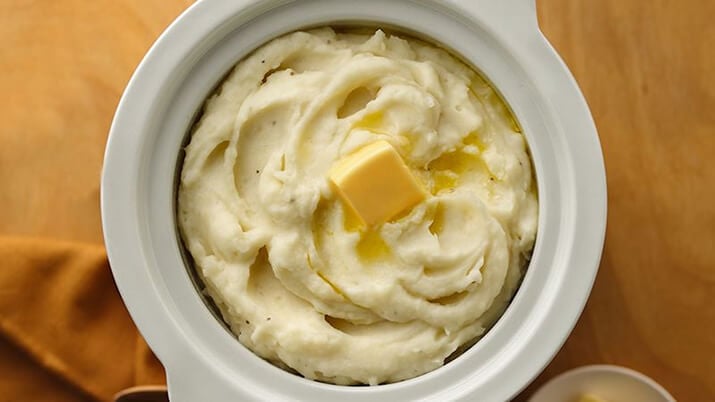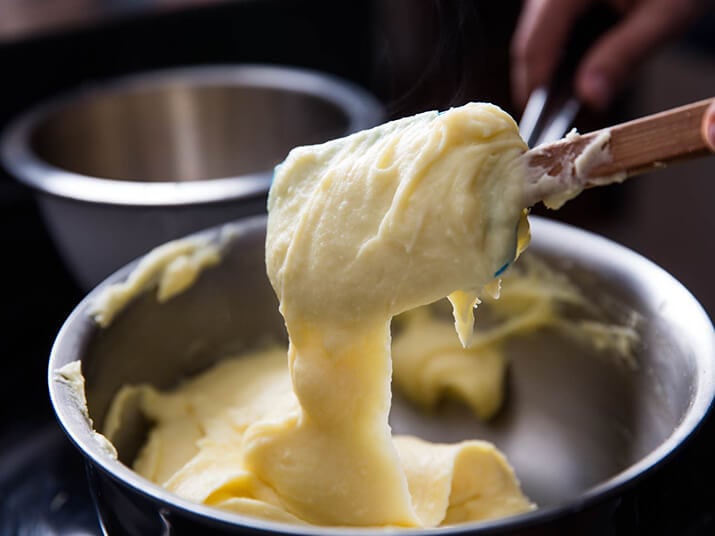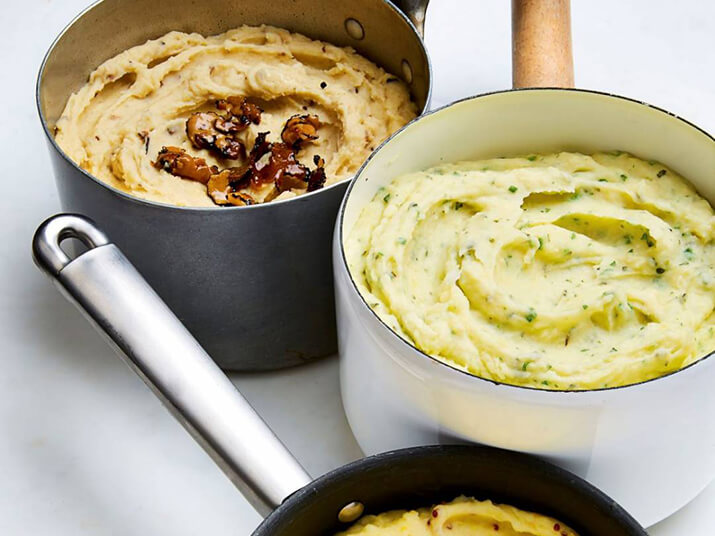kings counter
The Ultimate Guide To Thanksgiving Mashed Potatoes

With Thanksgiving around the corner, home chefs across the country are gearing up to create some amazing food. While Thanksgiving in 2020 might look a little different from the holiday in years past, that doesn’t mean we still can’t enjoy some great thanksgiving mashed potatoes.
In our Ultimate Guide to Thanksgiving Mashed Potatoes, we’ll cover some tips and tricks for getting the fluffy mash right and share a few recipes from master chefs.
Tips For The Perfect Mashed Potatoes
Whether you’ve been making mashed potatoes at Thanksgiving since you were as tall as the kitchen counter or this is your first year, it can be helpful to take a step back and ask, what are mashed potatoes?
Think of mashed potatoes as being made of three main components: boiled potatoes, ingredients added for texture, and ingredients added for flavor. Of course, ingredients overlap in these categories, but the general idea is that you want to achieve the correct texture and flavor.
Now, everyone can have a different idea of what a “correct” mashed potato texture is. But the texture should neither be too gummy or too runny. Similarly, the right flavor is subjective, but butter, garlic, white pepper, and cream are popular. Let’s look at a few tips for making the best mashed potatoes.
What Is The Best Kind Of Potatoes To Use For Mashed Potatoes?
Yukon Gold and Russet potatoes are both great options. Yukon Golds, also called yellow potatoes, have a medium level of starch that allows them to be creamy and delicious, as well as easy to work with. Russet potatoes have a bit more starch so they tend to be lighter and fluffier when mashed. You can mix these two varieties for a great all-around mash.
How Do You Keep Mashed Potatoes From Getting Gummy?

Gummy potatoes are the worst, and there are a number of ways to end up with them, unfortunately. Make sure you’ve started with Yukon Gold or Russet potatoes, first. Then, cut them into chunks of uniform size so they can cook evenly. Chunks should be one to two inches, and Russet potatoes should be peeled.
Start with cold water on the stove, not hot, to ensure even cooking. Boil for 20 minutes. After cooking and draining, return them to the pot to let the remaining moisture cook off.
Use a hand masher, food mill, or ricer to mash the potatoes, not a blender or food processor. The food processor can break down the starch and turn it into a block of chewing gum. Also, don’t over-mix, since that can also make the potatoes gum up.
Mash until it’s just right, and when you add ingredients after that, fold them in with a spatula. Speaking of ingredients, try to warm them up to the temperature of the potatoes before you add them, as well.
How Far Ahead Can You Make Mashed Potatoes?
You can make dairy-based mashed potatoes up to two days in advance. The basic idea is to mash the potatoes, add cream, and just a little butter and salt. Then, you can keep it in the fridge and reheat it two days later, adding the remaining butter at that time.
Do You Peel Potatoes Before Boiling?
Experts weigh in on both sides of this issue. To some, leaving the skin on during boiling is ideal because it allows more of the nutrients to be absorbed into the mash later on. The boiled skin comes off easy, too, so you don’t have to have it in the mashed potatoes if you don’t want to. But let’s face it, you probably aren’t eating buttery Thanksgiving potatoes for the health benefits.
On the other hand, peeling before you boil makes sense, too. You don’t have to wait for boiled potatoes to cool in order to peel them, and peeling beforehand ensures your mashed potatoes will be as smooth as possible. At the end of the day, it’s really up to you.
How 3 Celebrity Chefs Make Mashed Potatoes
Learning how to make the best mashed potatoes takes practice. So, let’s take a look at how a few master chefs make mashed potatoes. Don’t worry, you don’t need a culinary degree to follow these simple steps. But if you don’t cook your potatoes properly, Gordon Ramsay may call you to say, “It’s raw!”
1. Alton Brown’s Mashed Potatoes Recipe

If you’re at all unsure about what you’re doing in the kitchen, Alton Brown is the one to consult. Alton Brown’s recipe is based on his exacting food science and leaves nothing to chance. Here are your ingredients:
- 2 pounds Yukon gold potatoes
- 1/2 cup heavy cream
- 4 ounces unsalted butter, cut into pieces
- 1 teaspoon kosher salt
- 1/4 teaspoon freshly ground black pepper
- Food mill
And here’s what to do:
- Cut the potatoes into half-inch uniform pieces after peeling them.
- Put them into a pot and cover them with cool water by at least an inch.
- Cover and bring to a boil on high heat. When it starts boiling, take off the lid and reduce the heat to keep the water at a simmer.
- Cook the potatoes until you can crush them easily with tongs, which is about 15 to 20 minutes. Then drain them in a colander.
- In the empty saucepan, add the butter, salt, and pepper and put it back on the heat until the butter is melted.
- Take the mixture off the heat and put your food mill on the top of the pot.
- Process one cup of potatoes at a time through the mill. Once everything has been milled, stir it up. Taste and adjust the seasoning if needed.
2. Gordon Ramsay’s Mashed Potatoes Recipe

If you’re looking to spice things up a bit, take a chance on Gordon Ramsay’s decadent mashed potatoes recipe. It comes with three variations so to make mustard mash, truffle mash, or garlic and herb mash as well. Here are your ingredients:
- 1 kg (about 2 lbs) Yukon Gold or Désirée potatoes, peeled and cut into 1cm cubes
- 75 g (5 tbsp) butter
- 100 ml (½ cup) whole milk
- 100 ml (½ cup) double cream
- Sea salt and freshly ground black pepper
For mustard mash, you’ll need:
- 1 tsp English mustard
- 1 tbsp Dijon mustard
- 2 tsp wholegrain mustard
Truffle mash requires:
- 30 g (2 tbsp) porcini and truffle paste
- 30 ml (2 tbsp) white truffle oil
And garlic and herb mash requires:
- 2 garlic cloves, peeled, and crushed
- 2 tbsp woody herbs (rosemary, thyme, sage) leaves finely chopped
- 2 tbsp soft herbs (parsley, chives, dill) finely chopped
Here are the steps for Gordon’s creamy mashed potatoes recipe:
- Boil the cubed potatoes on medium-high heat for 15 minutes with the lid on.
- For garlic and herb mash: Cook the garlic and woody herbs in the butter for two to three minutes in a pan. Add the milk and cream and bring to a simmer. Then, add the soft herbs and simmer for another two or three minutes.
- For regular, mustard, or truffle mash: Put the butter, cream, and milk into a saucepan and bring to a simmer. Add the mustard ingredients or truffle ingredients to the simmering cream.
- Drain the potatoes and process them through a ricer. Do this as quickly as possible to enjoy fluffy potatoes. Return them to the saucepan.
- Add the flavored cream mixture and fold it into the potatoes. Season to taste with salt and pepper.
3. Jamie Oliver’s Ultimate Mash

How does Jamie Oliver make mashed potatoes? You’re about to find out. The popular English chef uses just a few ingredients in his mashed potatoes recipe:
- 2 kg (about 4 ½ lbs) Maris Piper potatoes
- 50 g (about 3 ½ tbsp) unsalted butter
- 100 ml (about ½ cup) milk
- Salt and pepper
Maris Piper potatoes are a popular white potato in England, but Yukon Golds or Russets will work for this recipe as well. Here’s what to do:
- Peel potatoes and chop them into two-inch chunks.
- Boil in salted water for 15 to 20 minutes over medium heat.
- Drain potatoes in a colander and leave them alone for a few minutes to let excess water evaporate.
- Put them back in the pan and mash them with a hand masher.
- When the potatoes are almost smooth, add half of the butter, all of the milk, and salt and pepper to taste.
- Mash the ingredients into the potatoes until they are smooth. You can adjust the seasoning or add a bit more milk if needed.
- Transfer the potatoes to a warm serving dish and plop the rest of the butter on top.
It’s not rocket science, but it does take some work to get creamy mashed potatoes to come out perfectly. We hope these different mashed potato recipes can give you some inspiration for the holidays.
Common Questions About Mashed Potatoes
Are Yukon Gold the same as yellow potatoes?
Technically, Yukon Gold potatoes are a variety of yellow potatoes, but for the purposes of mashed potatoes, they can be used interchangeably. Recipes and food blogs often use the terms interchangeably, as well.
Should I soak my potatoes before making mashed potatoes?
You don’t have to. The reason people do this is to remove amylose, which is what makes potatoes gluey. However, to get any benefits, you’d have to dice your potatoes into small cubes and let them soak for several hours.
Instead, put your chopped potatoes on to boil. Halfway through, strain them and rinse the potatoes in cold water. This will remove much more amylose than soaking before boiling does, and it will contribute to fluffy potatoes.
What can you put in mashed potatoes instead of milk?
You can use starchy potato water instead of milk, or you can use a milk substitute like oat milk. Just make sure the milk substitute is unsweetened. You could also use dairy-free butter, vegetable stock, or chicken stock.
Which potatoes are healthiest?
Sweet potatoes and purple potatoes are generally considered the healthiest since they both have many nutrients because of their bright colors. Yukon Gold potatoes are also healthy since they have yellow pigmentation.
![See your dream kitchen in 3D [GET YOUR FREE DESIGN]](https://cdn.kitchencabinetkings.com/blog/wp-content/uploads/see-your-dream-kitchen-in-3d.webp)
![Contractor Discount Program: Offering contractors and builders special volume discounts on all applicable orders [LEARN MORE]](https://cdn.kitchencabinetkings.com/blog/wp-content/uploads/contractor-discount-program.webp)
![Explore our photo gallery [GET INSPIRED]](https://cdn.kitchencabinetkings.com/blog/wp-content/uploads/explore-our-photo-gallery.webp)
![What everyone is saying about KCK [READ REVIEWS]](https://cdn.kitchencabinetkings.com/blog/wp-content/uploads/what-everyone-is-saying-about-kck.webp)
![Get a cabinet sample [SHOP SAMPLES]](https://cdn.kitchencabinetkings.com/blog/wp-content/uploads/get-a-cabinet-sample.webp)
![Pay over time, on your terms with Affirm [LEARN MORE]](https://cdn.kitchencabinetkings.com/blog/wp-content/uploads/pay-over-time-on-your-terms-with-affirm.webp)